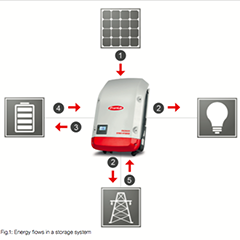Words: Franz Breitwieser, Product Manager, Fronuis International
The trend in recent years of rising electricity prices and the falling costs of photovoltaic (PV) systems mean that the cost of generating electricity from PV is now significantly lower than the purchase price of electricity. With feed-in tariffs falling steadily at the same time, it is becoming an increasingly attractive proposition for system owners to use the energy they generate themselves rather than to feed it into the grid.
1. Introduction
To maximise what is referred to as self-consumption, electrical storage systems are frequently being used alongside energy management systems. These PV storage systems demand much more complex control systems and current flows from the inverters than has previously been the case. This is exacerbated by the fact that the use of storage systems is resulting in a greater focus not only on maximising self-consumption but also the use of additional functions, such as:
Optimised response to load – and/or time-dependent electricity tariffs
Improvements in grid quality (e.g. voltage retention)
Emergency power in the event of a power failure
The following illustrates what effects these functions have on the technical demands placed on the inverter and how the Fronius Symo Hybrid series satisfies these demands.
2. Energy flows in the storage system
A fully configured PV storage system can be characterised by the five load flows shown in (Fig. 1).
1. PV generator → inverter: PV current
2. Inverter → consumer or into the grid: feed-in current
3. Inverter → battery: charging current to the battery
4. Battery → inverter: discharge current from the battery
5. AC grid → inverter: charging current to the battery from the AC grid
The first two energy flows are typical of a PV system with no storage facilities. However, storage systems must also be able to handle energy flows nos. 3 and 4 so they can charge and discharge the battery. Energy flow no.5 – charging the battery from the AC grid – is not an absolute requirement as a basic function of a storage system, which is why this operating mode is not supported by every type of storage inverter. Be that as it may, this operating mode supports numerous additional applications, some of which are already important today and will become increasingly so in the future, as the following examples show.






























